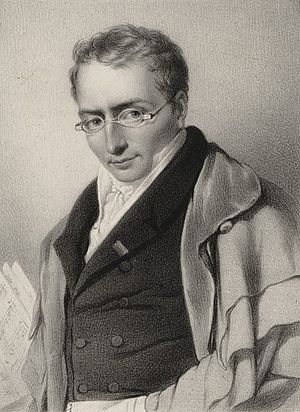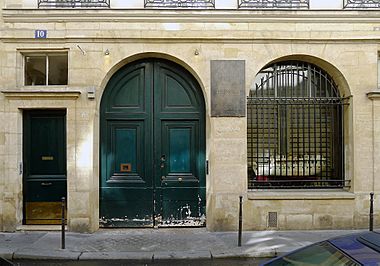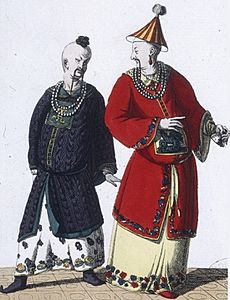Ferdinand Hérold facts for kids
Louis Joseph Ferdinand Herold (born January 28, 1791 – died January 19, 1833), known as Ferdinand Hérold, was a French composer. He was famous during his lifetime for his operas. He wrote more than twenty operas, along with ballet music, piano pieces, and choral works. Today, he is best known for the ballet La Fille mal gardée and the exciting music (overture) from his opera Zampa.
Hérold was born in Paris into a musical family. He studied at the Paris Conservatoire, a famous music school. In 1812, he won France's top music award, the Prix de Rome. After spending time in Italy, he returned to Paris. He worked at the Théâtre Italien and later at the Paris Opéra. He composed several ballets for the Opéra. However, he was most famous for his opéra comique works. These are operas that include spoken dialogue, not just singing.
Some of his early operas had weak stories (called librettos). But later, he had many more successes. His last two operas, Zampa (1831) and Le Pré aux clercs (The Clerk's Meadow, 1832), were very popular. They were performed for many years in France and other countries. Hérold died young in 1833 from tuberculosis.
As a ballet composer, Hérold was a pioneer. He helped make ballet music much better. Before him, ballet scores were often just simple versions of popular songs. Hérold created well-orchestrated music that truly told the story of the ballet. His operas also influenced later famous composers. These included Bizet, Offenbach, Wagner, and Smetana.
Contents
Life and Career
Early Life and Training
The Herold family came from Alsace, a region in France. Ferdinand's father, François-Joseph Herold (1755–1802), was also a musician. He studied with the famous composer C. P. E. Bach. In 1790, he married Jeanne-Gabrielle Pascal. Their only child, Ferdinand Hérold, was born in Paris on January 28, 1791. The street where he was born is now named after him.
Ferdinand's father wanted him to have a good general education. So, at age eleven, Ferdinand went to a top boarding school in Paris. He studied music there, including solfège (music reading) and piano. His godfather, Louis Adam, taught him piano.
Ferdinand's father did not want him to become a musician. But his father died in 1802 from tuberculosis. This allowed Ferdinand to follow his passion for music. In 1806, when he was almost 16, he joined the Paris Conservatoire. He studied piano, harmony, and violin there. In 1810, he won the Conservatoire's top prize for piano. He played one of his own compositions.
In 1811, he joined the composition class of Étienne Méhul. Méhul was a great composer who saw Hérold as his successor. He became like a father to Hérold. In 1812, Hérold's music was performed in public for the first time. This included a piano concerto where he played the solo part.
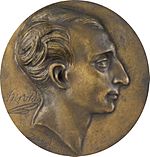
In October 1812, Hérold won the Prix de Rome. This was France's most important music award. He won it with a cantata (a type of vocal composition) called La Duchesse de la Vallière. The prize meant he could live and study at the Villa Medici in Rome. He went there in 1813. In Rome, he wrote his first symphony and an anthem. Like his father, Hérold suffered from tuberculosis. The climate in Rome was not good for him, so he moved to Naples in 1815.
In Naples, Hérold gained the support of Joachim Murat, who was then the King of Naples. Hérold became the court pianist for Murat's wife, Queen Caroline. He also taught music to their daughters. In 1814, Hérold was asked to write his first opera, La gioventù di Enrico quinto. It was performed in January 1815. Soon after, Hérold left Naples and traveled back to Paris. He visited Rome, Venice, and Vienna, where he met Antonio Salieri and heard operas by Mozart.
Return to Paris and Successes
Hérold returned to Paris in August 1815. He became a deputy conductor at the Théâtre Italien. In 1816, he worked with composer François-Adrien Boieldieu on an opera called Charles de France. Hérold wrote the second act. That same year, his opera Les Rosières was successfully performed. He had another hit with La Clochette (The Bell, 1817). This opera was based on the story of Aladdin. It was popular in Paris and even performed in Vienna.
After these successes, Hérold struggled to find good stories for his operas. He had four failures in a row between 1818 and 1821. Because of this, he stopped composing operas for more than two years.
In 1821, Hérold traveled to Italy to find new works and singers for the Théâtre Italien. He visited seven major Italian cities. He saw operas by Rossini, which impressed him greatly. He also hired famous singers like Giuditta Pasta for Paris.
In 1823, Hérold had another opera performed, Le Muletier. Even though the story wasn't great, the music was well-liked. Some experts say that in Le Muletier, Hérold found his unique musical style for the first time. Another short opera, L'Asthénie, had a moderate run but didn't get good reviews. It wasn't until 1826 that he had another big success with Marie.
In November 1826, Hérold left his job at the Théâtre Italien. He became the senior voice coach at the Opéra. He worked on major operas like Guillaume Tell. Because of this job, he couldn't have his own operas performed at the Opéra. So, for the next three years, he mainly wrote ballet music. His ballets included Astolphe et Jaconde (1827), La Somnambule (The Sleepwalker) (1827), La Fille mal gardée (1828), and La Belle au bois dormant (The Sleeping Beauty) (1829).
Hérold married Adèle Elise Rollet in 1827. They had three children. His son, Ferdinand, became a lawyer and later a senator. His daughter, Eugénie, was a talented musician. Sadly, like her father and grandfather, she suffered from tuberculosis and died at age 20.
Final Years and Masterpieces
The last three years of Hérold's life were spent writing his two most famous works: Zampa (1831) and Le Pré aux clercs (1832). Zampa had a romantic story that the public loved. It quickly became one of the most popular opéras comiques of the 19th century. It was even performed in the US and Britain in 1833.
In mid-1832, the Opéra-Comique had to close due to a cholera outbreak. During this time, Hérold finished Le Pré aux clercs. This opera was based on a historical novel. It was first performed on December 15, 1832, and was a huge success.
By the time Le Pré aux clercs premiered, Hérold's tuberculosis was much worse. He had to work very hard to rehearse a new singer at the last minute. Five weeks after the premiere, he died at his home in Paris. He was only 42 years old. He was buried at Père Lachaise Cemetery.
Hérold left an opera called Ludovic unfinished. His friend Fromental Halévy completed it, and it was performed three months after Hérold's death. By the end of the 1800s, Le Pré aux clercs had been performed more than 1,500 times in Paris.
Music
Ballets
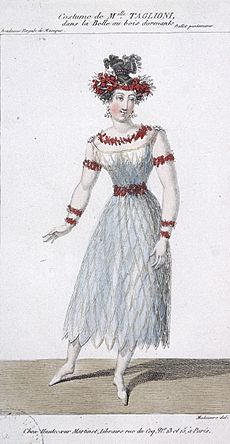
Before Hérold, ballet composers were not highly regarded. Ballet music was often just simple versions of popular tunes. Hérold, along with his friend Adolphe Adam, helped to raise the quality of ballet scores. Hérold still used some well-known opera tunes in his ballets. This helped the audience understand the story. But he chose them carefully. La Belle au bois dormant is an early example. It used music from other composers like Weber. This showed the first steps towards more dramatic ballet music.
Hérold was known for his elegant way of arranging music for instruments (orchestration). He also had a rich sense of melody and could create dramatic effects. However, he didn't always treat ballet composing as seriously as his operas. He was known to compose ballets while talking to friends at the dinner table! When friends asked why he spent his talent on such "easy" work, he replied, "The more I write, the more ideas come to me."
Hérold is famous for the music of La Fille mal gardée. However, the music he wrote in 1828 is quite different from what is played in modern versions of the ballet. His original score included music from earlier versions of the ballet and other sources. Later productions added music by Peter Ludwig Hertel. The most famous part, the clog dance, was created much later by John Lanchbery in 1959. Lanchbery felt that Hérold's ballet music was not as good as his opera music, probably because it was written quickly.
For the ballet La Somnambule, Hérold created graceful, peaceful music. He cleverly used musical themes (melodic motifs) to connect the music to the story.
Operas
Even with some weak stories in his early operas, Hérold's talent for musical drama was clear from the start. He improved the opéra comique style. He used colorful and varied orchestration. He was also good at smoothly moving between spoken and sung parts in his works. His opera La Clochette was praised for its new ideas and original use of instruments.
After La Clochette, some of his operas had stories that were "neither interesting nor adapted for music." But Le Muletier (1823) was "full of life and color" and made his reputation stronger. It's surprising that Hérold, who had good taste in literature, chose to set such "tame and uninteresting" stories later on. Perhaps his strong desire to compose made him accept any story offered.
By the time of his comedy Marie (1826), Hérold was using musical ideas from both Rossini and Beethoven. Marie was a key turning point in his writing. The poet Gérard de Nerval called it the "golden link" between Hérold's early operas and his later masterpieces, Zampa and Le Pré aux clercs.
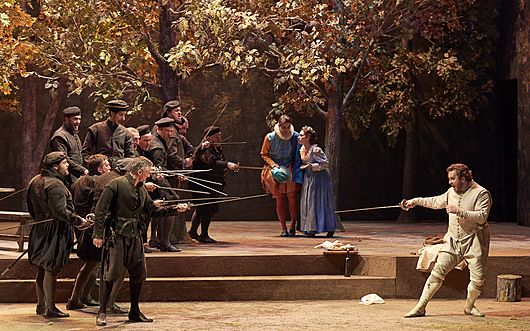
For Zampa, Hérold wrote an overture (the music played before the opera starts) that has five different themes related to the story. In Zampa, Hérold showed great skill in making the different parts of the opéra comique unique. He created solo songs for characters and large final scenes that built to a dramatic peak. Some critics, like Berlioz, thought Hérold's music was "Parisian music" – well-made but not truly original. However, Zampa's romantic style made it very successful outside France.
Experts agree that Le Pré aux clercs is one of the best operas of its time. The story is similar to Meyerbeer's Les Huguenots, but it's more personal. The music is a series of beautiful songs, very melodic and pretty. It also suits the characters and story well, balancing comedy and romance. Many later composers, including Lecocq, Offenbach, and even Bizet, learned from Le Pré aux clercs. In the overture, Hérold uses new themes, not from the opera itself. Composers like Wagner and Smetana knew this opera well. Echoes of Le Pré aux clercs can be found in their works. If Hérold had lived longer, he might have achieved his dream of composing a grand opera.
List of Works
Operas
- 1815 La gioventù di Enrico quinto
- 1816 Charles de France ou Amour et gloire
- 1817 Les Rosières
- 1817 La Clochette ou Le diable page
- 1823 Le Muletier
- 1826 Marie
- 1831 Zampa ou La Fiancée de marbre
- 1832 Le Pré aux clercs
- 1833 Ludovic (finished by Halévy)
Ballets
- 1827 Astolphe et Joconde
- 1827 La Somnambule
- 1828 La Fille mal gardée
- 1829 La Belle au bois dormant (The Sleeping Beauty)
Other Music
Hérold also wrote choral pieces, piano music, and instrumental music. His instrumental works include:
- 2 symphonies
- Air varié for bassoon
- Trio for two bassoons and horn
- 3 String Quartets
See also
 In Spanish: Ferdinand Hérold para niños
In Spanish: Ferdinand Hérold para niños


